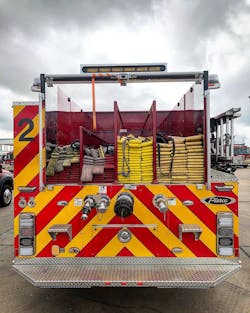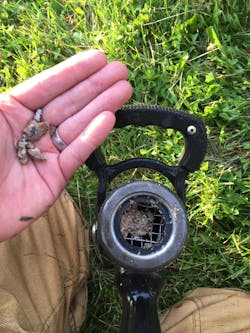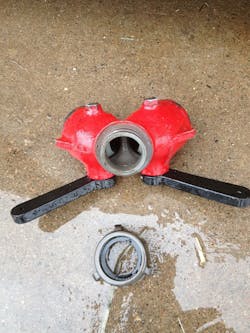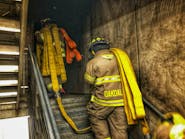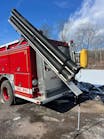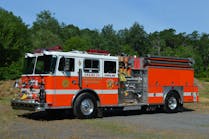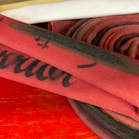Engine Essentials: Backup Line Considerations
Once the primary attack line is stretched and in operation, consideration must be given to stretching a backup line. A dedicated backup line is a contingency line that provides for occupant and firefighter safety, because it’s stretched and placed in position to directly support the primary attack line should unforeseen circumstances arise.
Often, the second-arriving engine company is tasked with deploying the backup line. However, if the primary attack line isn’t in service because of a difficult stretch or other extenuating circumstances, the second-arriving engine company should assist with the primary attack line. It’s critical that engine companies focus on getting the first line in operation first prior to concerning themselves with the backup line. Later-arriving engine companies can be assigned the task of the backup line.
Definitions
Backup lines are defined differently depending on the jurisdiction. Some departments assign engine companies to operate the backup line in close proximity to the primary attack line to reinforce their position. Other departments treat the backup line as a secondary attack line proceeding to other areas of the structure, often above the main body of fire, to check for fire extension. Even others assign personnel to a backup line that stands by in an “on-deck” position outside of the structure.
NFPA 1410: Standard on Training for Emergency Scene Operations has clear definitions for the initial attack line and for the attack line. It defines the initial attack line as, “The first hose stream placed in service by a company at the scene of a fire in order to protect lives or to prevent further extension of fire while additional lines are laid and placed in position.” NFPA 1410 defines an attack line as, “A hoseline used primarily to apply water directly onto a fire and operated by a sufficient number of personnel so that it can be maneuvered effectively and safely.” Per NFPA 1410, these are the hoselines that protect lives by defending the means of egress and, ultimately, applying water to the fire.
NFPA 1410 provides a definition for the backup line that distinctly differentiates it from attack lines: “An additional hoseline used to reinforce and protect personnel in the event the initial attack proves inadequate.” It’s clear by this definition that the backup line’s principal goal isn’t to apply water to the fire but instead to support the attack line and to provide an additional level of safety for operating personnel and occupants.Dedicated backup reasoning
The goal of the initial attack line is to place the hoseline between the fire and the occupants to allow them to safely egress from the structure. A similar concept applies to the backup line: The goal is to place the hoseline between the primary attack line and their means of egress. This ensures that if fire extends over the attack line, if the attack line passes fire or if conditions rapidly change, the backup line can hold the means of egress to allow personnel time to rectify the situation or to retreat to a safe location.
The backup line also provides tactical redundancy: If the primary attack line loses water/pressure or the capability to operate, the backup line is put to work.
The primary attack line can fail for numerous reasons, which could prove disastrous for crews that operate in an immediately dangerous to life and health (IDLH) atmosphere. Failure can occur because of: mechanical reasons (clogged nozzles, kinks, pinched hoselines, burst hose lengths, apparatus or pump breakdowns); thermal insult of the hoseline itself or the personnel who operate it; and operator error (inadequate pump discharge pressures, running out of water or accidentally shutting down a hoseline).
Finally, the backup line allows for a temporary increase in water application rate. A properly selected primary attack line should be capable of extinguishing the fire during an interior attack. However, if the fire proves too much for the primary attack line, the backup line should be in close proximity, to temporarily augment the attack line. This should be done to buy time until a large handline can be placed in operation, personnel can safely retreat or the additional gallons per minute rapidly knock down the fire.Selection & water supply
Certain items must be considered when selecting the proper hoseline to deploy for use as the backup line.
To start, fire conditions must be examined closely to determine the diameter of hoseline to be stretched. In general, the backup line should be the same size or larger than the initial attack line. Attention must be given to NFPA 1710: Standard for the Organization and Deployment of Fire Suppression Operations, Emergency Medical Operations, and Special Operations to the Public by Career Fire Departments, which states that departments at single-family dwelling fires must establish “an effective water flow application rate of 300 gpm from two handlines, each of which has a minimum flow rate of 100 gpm.” If conditions don’t rapidly improve with water application from the primary attack line, the engine company that’s tasked with operating the backup line should stretch a larger diameter hoseline.
In addition to hoseline diameter, consideration must be given to hoseline length. The backup line often must be longer than the primary attack line for two reasons. First, the backup line frequently comes off of an engine company that’s farther from the scene because of apparatus positioning by the initial engine and truck companies. Second, once the main body of fire is knocked down, the backup line often proceeds to other areas of the structure, often the floor above, to check for fire extension. This requires hosebeds to be set up to facilitate longer lays and members to be trained to deploy these longer lines with speed and efficiency.
Final consideration must be given to which apparatus the backup line is pulled from as well as how that apparatus receives its water supply.
The goal of the backup line should be complete tactical redundancy. That means it should be pulled and supplied from a different engine company than the primary attack line is pulled and supplied from. This ensures that the backup line remains unaffected by mechanical failure of the primary attack line apparatus/pump. This also supplies two onboard tanks of water for suppression activities until positive water supplies are established.
If possible, the backup line should be supplied from a separate hydrant to safeguard against water/pressure loss because of supply issues that might arise.
Caution should be given to supplying the primary attack line and backup lines with a single hoseline, whether that be large-diameter hose/supply line from the hydrant or through use of a gated wye at the end of a leader line. Failure of a single length of hose or an appliance could cause water loss in both hoselines.
These considerations are in line with NFPA 1403: Standard on Live Fire Training, which states, “Separate water sources shall be utilized for the supply of attack lines and backup lines in order to preclude the loss of both water supply sources at the same time.”Line placement
Once the proper diameter and length of hose are selected, careful consideration must be given to proper placement of the backup line. To achieve the goal of protecting the means of egress for the primary attack line, the backup line should be stretched through the same point of entry that the attack line is stretched. As the backup line is stretched, care should be given not to place it on top of the attack line, which inevitably results in increased difficultly in advancement and tangled hoselines.
The backup line should be charged and bled outside of the IDLH environment.
Once personnel are ready, the hoseline should be advanced through the structure using the same path as the primary attack line. This ensures that if personnel must retreat, they can follow their hoseline to a point of egress or safe refuge.
The backup line should advance to such a position that it can protect the primary attack line with the reach of its stream if conditions change.
Although they should be close, it’s important that the backup line doesn’t crowd the attack line, so each has room to maneuver to attack the fire as well as retreat if conditions on the fireground change.
Personnel who are on the backup line must remain vigilant for changing fire conditions or any fire that the primary attack line might pass. They always must be prepared to open the nozzle to protect the attack line if conditions warrant.
Policies & procedures
Departments should develop policies and procedures to ensure complete tactical redundancy of their attack line through the use of a dedicated backup line. As always, it’s critical that engine company personnel train on the proper deployment and operation of the backup line prior to needing it on the fireground.

Jonathan Hall
Jonathan Hall, who is a Firehouse contributing editor, has more than 24 years of fire service experience. He currently is a captain with the St. Paul, MN, Fire Department assigned to Engine Company 14. Hall also serves as a lead instructor in the department's Training Division; he teaches hands-on skills to members of all ranks. Hall is the co-owner of Make The Move Training LLC and teaches engine company operations throughout the country.

